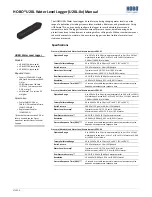
HOBO U20L Water Level Logger (U20L-0x) Manual
1-800-LOGGERS 5
www.onsetcomp.com
Alternatively, you could deploy the logger in a stilling well
as described above.
•
Be very careful not to exceed the burst pressure for the
logger. The pressure sensor will burst if the maximum
depth is exceeded (see specifications table). The logger
should be positioned at a depth where the logger will
remain in the water for the
duration of the deployment,
but not exceed the rated bursting depth.
To deploy the logger:
1.
Cut wire to suspend logger.
a.
Measure the physical depth to the surface of the water
from the suspension point.
b.
Cut a piece of stranded, stainless steel wire (Teflon
coated is best) so that the logger will be deep enough to
always be in the water. Estimate the low water level
and make the cable length such that the logger will be
about 2 feet below that level.
2.
Attach the wire to the suspension point and to the logger
cap.
3.
Relaunch the logger if desired (if a laptop or a HOBO
U-Shuttle is available).
4.
Lower the logger into the well or stilling well.
5.
Measure the water depth from the desired reference point
(top of pipe, ground level, or sea level).
•
To maximize accuracy, allow 20 minutes after deploying
the logger before measuring water depth to allow the
logger to reach temperature equilibrium with the water.
•
If the well is too small in diameter to measure the water
depth after deployment, measure the water depth
before deployment, then deploy the logger immediately
and record deployment time.
•
For well deployments: If the water level surface is below
the reference point (such as referencing groundwater
measurements to the top of the well), record the water
level as a negative number. If the water level surface is
above the reference point (such as height above sea
level), record the water level as a positive number.
•
For lake, stream, and river deployments: If the water
level is being referenced to some point above the logger
(such as the top of the stilling well), record the water
level as a negative number. If the water depth is being
referenced to a point below the water surface such as
the bottom of the stream, record the water level as a
positive number.
6.
Record the reference measurement date and time.
Deploying a Water Level Logger for Barometric
Pressure Data (Optional)
If you are using a U20 or U20L logger to record barometric
pressure data, install one logger in one of the wells as follows:
1.
Cut wire for suspending the logger.
a.
Measure the physical depth to the surface of the water
from the suspension point.
b.
Cut a piece of stranded, stainless steel wire (Teflon
coated is best) so that the logger will hang about 2 feet
below the ground surface but always above the water
surface.
2.
Attach the wire to the suspension point and to the logger
cap.
3.
Relaunch the logger if desired (if a laptop or a HOBO
U-Shuttle is available).
4.
Lower the logger into the well or stilling well. Make sure the
logger does not go below the water surface. See the
diagram in the previous section.
5.
Record the deployment time.
Reading Out the Logger
To read out the logger for water level data (see later in this
section for steps to read out a water level logger used for
barometric pressure data):
1.
Measure the water depth using the original reference point
with the correct sign.
2.
Record depth and date and time.
3.
Pull the logger out of the well.
4.
Remove the logger from its cap, leaving the suspension
undisturbed. Check the communications window for any
fouling and wipe it off if necessary.
Note:
There may be
water in the end cap. This is normal; this water will not
penetrate the waterproof seal around the communications
window in the logger.
5.
Read out the data using a laptop or shuttle.
6.
Save the data in a test folder location.
7.
Redeploy the logger (optional) as described later in this
section.
To read out a U20L logger used for barometric pressure data:
1.
Remove the logger from the well.
2.
Read out the data using a laptop or shuttle.








